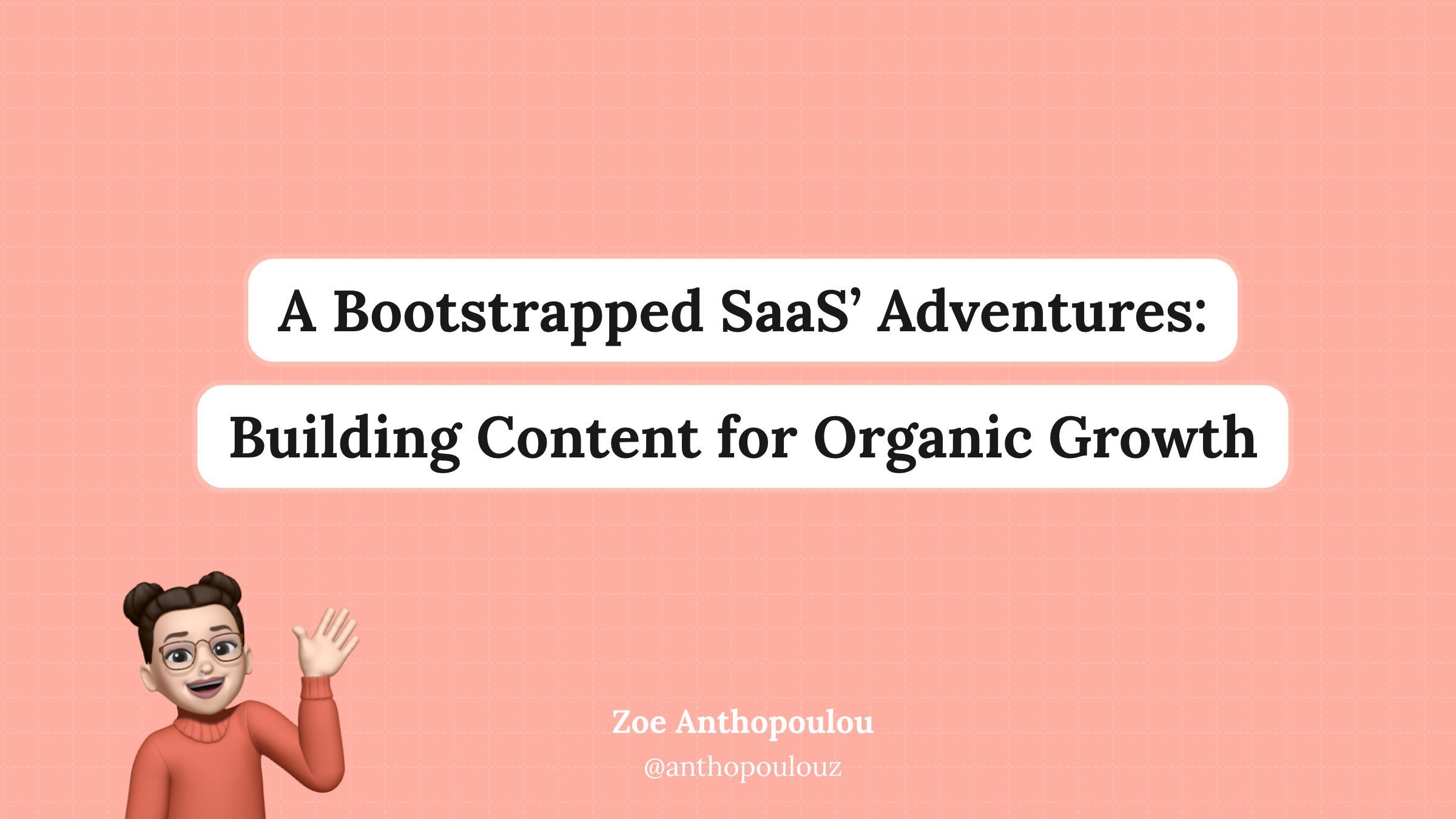A Bootstrapped SaaS’ Adventures: Building Content for Organic Growth

Zoe Anthopoulou
16 Aug 2024

Welcome to the second post of my "A Bootstrapped SaaS' Adventures" series! As I promised in my previous post about organic growth and SEO (which you can find here: [link to previous post]), in this post I am going to tell you a bit more about our content creation process here at BrandBird, and how we are leveraging content to drive growth.
As I am a person who loves creating, I personally took upon the challenge to create content for our blog and set out to grow our organic traffic in the long term.
To be honest with you, at first I knew nothing. I just loved writing articles but that by itself cannot win you the SEO game. So, Jim offered his help, and led me on a research to find out how to write meaningful blog posts that could rank on Google and get us traffic.

Of course, the process of creating content may vary from business to business, depending on the resources they can allocate and their expertise. But this article is focused on…
How do we create content in BrandBird?
Before I go on, a disclaimer: this is a process that I set up myself that I found helps me as a beginner. It is not perfect, or polished, but it will sure help if you are looking for some basic steps to get started!
Now let's break down the process into four key steps:
1. Choose Your Topics
Selecting the right topics is the foundation for creating content. You want to find topics that attract and engage your target audience. Here are two things I do, that may help you as well:
👉 Understand your target audience
What is something your current customers and possible customers have in common? What are their needs, pain points, interests? You can learn a lot about your audience if you pay close attention to the feedback you get from your existing users.
Example: a big chunk of BrandBird’s users are founders that build in public, freelancers, content media managers; i.e. people who work a lot on their personal or product’s presence on social media. So, a lot of our articles focus on that: creating eye catching posts, branding your presence on social, etc.
👉 Check out your competitors
Once you get down your target audience and have a general idea on what your topics will be, take a look at your competitors or blogs with similar topics. What are they writing about? Is there a topic you might have missed? Is there a topic that has been overanalysed?
Usually, a Google search around the topic will give you some blogs to look into. And with this research you can identify gaps you can fill with your articles, get a fresh perspective and come up with more ideas for topics.
2. Research the Keywords
Now that you found some interesting topics, it’s time to craft your content around them. Keyword research is what you want to do to find the content worth focusing on, and then optimise it for search engines by using the right keywords. Here’s what I do:
👉 Use keyword research tools
I use free tools like Google Keyword Planner, and Answer the Public to find relevant keywords and phrases.
In Google Keyword Planner you can search for keywords or add a website (like a competitor’s article) and find the relevant keywords. It can help you come up with more keywords and phrases for your content.
In Answer the Public, you can find questions and phrases around your keyword that a lot of people search for. So, you can come up with even more ideas for your content.
✨Tip: For your research to be right, you first want to make sure to select the region and language of your audience. Where do most of your customers reside and what language are they speaking?
👉 Find the keywords
You can start your research with simple keywords like “Twitter banner” and then find more keywords and phrases you can use for my articles from the tools’ suggestions. Basically, what you are looking for is keywords that have less competition (Low) but a decent search volume (>1K searches).
If you find that there are no keywords matching this description, then maybe it’s best to switch your content to a different direction.
Once you find your keywords, note them down in a list so you can use them later on.
3. Write the Articles
Here’s the fun part: creating the content and blending the keywords in there. Remember, the goal is to create content that not only ranks well but also provides genuine value to your readers.
👉 Develop a solid structure
The first step I take before writing an article, is make a clear outline of its cοntents. I start with a clear outline that includes headings and subheadings to organize my thoughts and make the content scannable. Once you get the article’s main structure down it will be easier to fill it up with content, instead of just looking down on a blank screen.
👉 Focus on the content
Your content should give value to your audience, so it’s important to provide them with accurate and valuable information over an article filled with just keywords. For this task you can put your own knowledge into use, but also leverage AI for more ideas and text generation.
Including media like relevant images, infographics, or videos is also super useful to make your content more engaging and scannable.
👉 Optimize for SEO
To optimize your content for SEO you need to incorporate the target keywords naturally into your title, headings, first paragraph, and throughout the content. It’s good practice to do this while writing the content, so the keywords don’t look just thrown in there. What I do is keep the list of the keywords open, so that I can easily pop them into the content while I am writing.
4. Create Backlinks
A backlink is when your site’s or articles’ URL is posted on another website, blog, or social media. Think of a backlink as a reference: it can take people to your site, but also improve your site’s authority. For your content to have optimal SEO you need backlinks. Some tips around backlinks are:
👉 Create link-worthy content
Here is another reason why creating good content is SO important. Good content increases your chance of someone finding it valuable and using it as a reference or just linking to it. This means more backlinks for you!
👉 Post on Social
Posting your content on social will not only bring it in front of people who may be interested in it, but will also create backlinks for it. You can simply post them from your personal or business account, but also look out for any questions or relevant posts from other people where you can post them as comments.
👉 Participate in online communities
This one is a bit harder, but you can also post your articles to online communities like forums, Q&A sites, and groups on social media platforms. The hard part is that your article should be relevant to the discussion so you’d have to check the new posts regularly and only respond to the ones where you can give value.
Remember, quality is key when it comes to backlinks. A few high-quality links from reputable sites in your industry are far more valuable than many low-quality links.
Conclusion
Creating content that drives organic growth is a marathon, not a sprint. It requires consistent work and patience. And your process and style of writing may change as you go, but you should always stick to writing if you want results eventually.
I hope this insight into our content creation process here at BrandBird has been helpful. Remember, what works for us might not work exactly the same for you, so don't be afraid to experiment and find what works best for your unique situation.
Stay tuned for the next article in our "A Bootstrapped SaaS' Adventures" series. Until then, happy creating!
